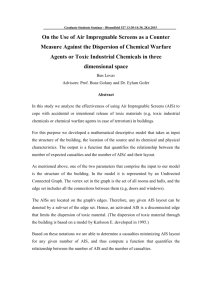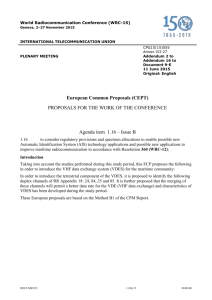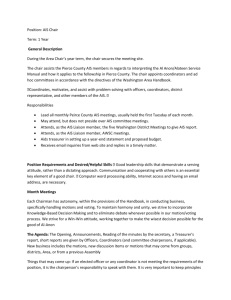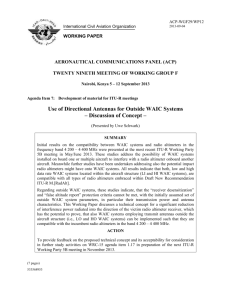APG15-4/INP-38 - Asia-Pacific Telecommunity
advertisement
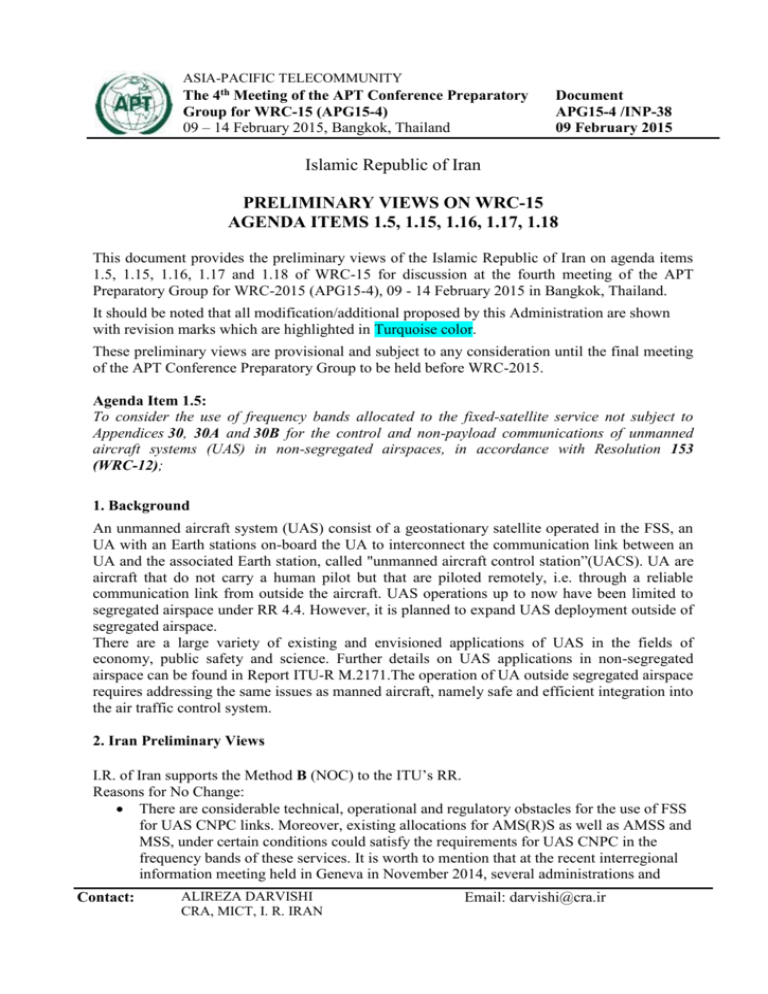
ASIA-PACIFIC TELECOMMUNITY The 4th Meeting of the APT Conference Preparatory Group for WRC-15 (APG15-4) 09 – 14 February 2015, Bangkok, Thailand Document APG15-4 /INP-38 09 February 2015 Islamic Republic of Iran PRELIMINARY VIEWS ON WRC-15 AGENDA ITEMS 1.5, 1.15, 1.16, 1.17, 1.18 This document provides the preliminary views of the Islamic Republic of Iran on agenda items 1.5, 1.15, 1.16, 1.17 and 1.18 of WRC-15 for discussion at the fourth meeting of the APT Preparatory Group for WRC-2015 (APG15-4), 09 - 14 February 2015 in Bangkok, Thailand. It should be noted that all modification/additional proposed by this Administration are shown with revision marks which are highlighted in Turquoise color. These preliminary views are provisional and subject to any consideration until the final meeting of the APT Conference Preparatory Group to be held before WRC-2015. Agenda Item 1.5: To consider the use of frequency bands allocated to the fixed-satellite service not subject to Appendices 30, 30A and 30B for the control and non-payload communications of unmanned aircraft systems (UAS) in non-segregated airspaces, in accordance with Resolution 153 (WRC-12); 1. Background An unmanned aircraft system (UAS) consist of a geostationary satellite operated in the FSS, an UA with an Earth stations on-board the UA to interconnect the communication link between an UA and the associated Earth station, called "unmanned aircraft control station”(UACS). UA are aircraft that do not carry a human pilot but that are piloted remotely, i.e. through a reliable communication link from outside the aircraft. UAS operations up to now have been limited to segregated airspace under RR 4.4. However, it is planned to expand UAS deployment outside of segregated airspace. There are a large variety of existing and envisioned applications of UAS in the fields of economy, public safety and science. Further details on UAS applications in non-segregated airspace can be found in Report ITU-R M.2171.The operation of UA outside segregated airspace requires addressing the same issues as manned aircraft, namely safe and efficient integration into the air traffic control system. 2. Iran Preliminary Views I.R. of Iran supports the Method B (NOC) to the ITU’s RR. Reasons for No Change: There are considerable technical, operational and regulatory obstacles for the use of FSS for UAS CNPC links. Moreover, existing allocations for AMS(R)S as well as AMSS and MSS, under certain conditions could satisfy the requirements for UAS CNPC in the frequency bands of these services. It is worth to mention that at the recent interregional information meeting held in Geneva in November 2014, several administrations and Contact: ALIREZA DARVISHI CRA, MICT, I. R. IRAN Email: darvishi@cra.ir APG15-4/INP-38 satellite operators clearly mentioned the inappropriateness and non-feasibility of the use of uncoordinated, incompletely coordinated commercial FSS which are not granted a safety service for unmanned aircraft which is of very highly safety application. Moreover no agreement was reached on the results of studies due to the fact that there is a major divergence of views on the appropriateness, feasibility of the use of the FSS for such a sensitive and delicate issue which is very high degree of importance in terms of safety of flight and satiety of life. In fact the study is at its very early stage and the activities of the ITU-R are in form of ‘Document toward Preliminary Draft New Report” which is far from being considered to yield an acceptable/agreed (See I.R. of Iran’s contributions for previous WP 5B meetings: Document 5B/596-E and Document 5B/595-E). However, no change is also being considered by these Administration acceptable /agreed results. This Administration in its contribution 5B/676 indicating that : Quote “This Administration maintains its position and is of the strong believes that: a. The introductory text should remain as it is until all questions are answered and all doubts are removed. b. The document, irrespective of its development should NOT BE UPGRADED to a PDNR. Until administrations which have raised concerns ,including this administration have the opportunity to attend the meeting and discuss the matters further with an objective that are divergence views are reconciled. c. The document should continue to be placed in physical bold square bracket until the subsequent meeting of WP 5B in 2015 in which this administration would have the opportunity to attend that meeting and discuss the pending issues in detail with other administrations.” Unquote Therefore, the title of the report of the document mentioned below should be as follows: – Document toward Preliminary draft new Report ITU-R RS.[UAS-FSS] – “Technical and operational characteristics, interference and regulatory environments associated with the use of frequency bands allocated to the fixed satellite service no subject to Appendices 30, 30A, and 30B for the control and non-payload communications of unmanned aircraft systems in non-segregated airspace” It is worth to mention that the referenced Resolution in Method A (Use of the fixed satellite service) was never ever discussed in any WP 5B Meetings, at all. It was attached to some input documents but due to the major disagreement about the subject matter the Resolution is question was just attached without being discussed. Moreover, the content of the Resolution is totally inappropriate and does not reflect the reality . As it is noted, there is a long list of disadvantage of Method A (More than 15 items) which indicate a considerable degree of non feasibility and inappropriateness of the use of commercial FSS : a) 50% of which have not completed the coordination and even have only coordinated with few among many affected administrations. b) Within the rest of 50% for which blanket coordination has been announced, there is no information on the level of interference that has been accepted. Page 2 of 9 APG15-4/INP-38 c) Moreover, even if and only if all coordination’s are completed ,there is no guarantee that the future commercial FSS satellites currently in operation would not cause harmful interference to the above- mentioned link. d) Occurrence of interference for fraction of minute could create a catastrophic results as tens of unmanned aircraft will be misguided which could collide with other unmanned and or manned aircraft. Agenda Item 1.15: To consider spectrum demands for on-board communication stations in the maritime mobile service in accordance with Resolution 358 (WRC-12); 1. Background Resolution 358 (WRC-12) invites WRC-15 to consider, based on the results of ITU-R studies, the need to possibly identify additional UHF channels within the bands already allocated to the maritime mobile service for on-board communication stations; invites ITU-R to conduct, in time for WRC-15, studies to determine the spectrum requirements and potential frequency bands for on-board communication stations, taking into account the protection of services to which the frequency band is currently allocated. Some UHF frequencies, in frequency range 450-470 MHz, are currently identified in Radio Regulation for on-board communication stations. Fixed and mobile services are allocated in frequency range 450-470 MHz on a primary basis. There are two footnotes in the Radio Regulations Article 5 related to the use of UHF on-board communication frequencies: RR No. 5.287 and RR No. 5.288. RR No. 5.287 says that in the maritime mobile service (MMS) six frequencies in UHF frequency band may be used by on-board communication stations: Quote 5.287 In the maritime mobile service, the frequencies 457.525, 457.550, 457.575, 467.525, 467.550 and 467.575 MHz may be used by on-board communication stations. Where needed, equipment designed for 12.5 kHz channel spacing using also the additional frequencies 457.5375, 457.5625, 467.5375 and 467.5625 MHz may be introduced for on-board communications. The use of these frequencies in territorial waters may be subject to the national regulations of the administration concerned. The characteristics of the equipment used shall conform to those specified in Recommendation ITU-R M.1174-2. (WRC-07) Unquote It should be noted that some administrations use these frequencies for land mobile service (LMS). In accordance with RR No. 5.286AA the frequency band 450-470 MHz is identified for use by administrations wishing to implement IMT. ITU-R Working Party 5B discussed methods at its 13th meeting in May 2014 concerning Agenda item 1.15 and the number of methods has been reduced to one. This method is described in the draft CPM text (Annex 3 to Document 5B/636) which supports analogue equipment using 25 kHz and 12.5 kHz channel spacing, digital equipment using on 12.5 kHz and 6.25 kHz channel spacing. The method also proposes not to identify new frequencies for on-board communications in UHF other than those indicated in RR. No. 5.287. Page 3 of 9 APG15-4/INP-38 2. Iran Preliminary Views This Administration supports the following: - The identification of new frequencies for on-board communications in UHF is not justified and therefore not necessary. - However the importance of on-board communications for ship safety operations is fully recognized, together with the congestion in some geographical areas. - A more efficient usage of the existing frequencies could be achieved with the systematic utilization of both 12.5 kHz and 6.25 kHz channel spacing for all the channels identified in the RR for on-board communications. The numbering of these channels should be clearly harmonized worldwide. - The implementation of digital technology will open the possibility for additional operational features and a number of different standards are available. - For analogue technology the use of CTCSS and DCS could be used as a way to mitigate the impression of congestion to the user. - For digital technology the use of DCS or an operational equivalent system could be used as a way to mitigate the impression of congestion to the user. The LBT technology should be used. - To achieve this, amendments to provision RR No. 5.287 and Recommendation ITU-R M.1174 are necessary. Provision is made for 25 kHz, 12.5 kHz and 6.25 kHz channel spacing. - To achieve a higher degree of flexibility for the use of systems, it is proposed to indicate two frequency bands in RR No.5.287. - No constraints should be placed on the existing 25 kHz analogue on-board communication systems with the least modification to existing equipment being preferable. The following modification is proposed for RR No. 5.287: MOD 5.287 Use of the bands 457.5125n is proposed for t being preferableems, i the maritime mobile service is limited to on-board communication stations. The characteristics of the equipment and the channeling arrangement shall be in conformity with Recommendation ITU-R M.1174-3. The use of these bands in territorial waters may also be subject to the national regulations of the administration concerned (WRC-15) Agenda Item 1.16: To consider regulatory provisions and spectrum allocations to enable possible new Automatic Identification System (AIS) technology applications and possible new applications to improve maritime radiocommunication in accordance with Resolution 360 (WRC-12) 1. Background Resolution 360 (WRC-12) resolves to invite WRC-15: Page 4 of 9 APG15-4/INP-38 1 to consider, based on the results of ITU-R studies, modifications to the Radio Regulations (RR), including possible spectrum allocations, to enable new AIS terrestrial and satellite applications, with ensuring that these applications will not degrade the current AIS operations and other existing services; 2 to consider, based on the results of ITU-R studies, additional or new applications for maritime radiocommunication within existing maritime mobile and mobile-satellite service allocations, and if necessary to take appropriate regulatory measures. 1.1 Automatic Identification System The AIS is a proven maritime data system, with a large number of ships equipped and a supporting terrestrial and satellite infrastructure established. The AIS is designed to assist safety of navigation. AIS is used in the ship movement service for safety of navigation, it enables the identification of stations using this system, provides information about a ship and its cargo. It provides a means for ships to exchange ship data, including identification, position, course and speed, with other nearby ships and coast stations. The shipborne AIS, mandated under Chapter V of the International Convention for the Safety of Life at Sea (SOLAS), has become well accepted by the maritime community and is also being used by thousands of ships not subject to the SOLAS Convention. The AIS is supported by a large number of shore based VHF infrastructures as well as being able to be detected by satellite, though its effectiveness is unacceptably limited where VHF data link (VDL) loading is high. The need for separate dedicated channels was recognized by WRC-12 and two additional channels were designated. This new designation solves the problem for satellite detection. AIS has the capability for data exchange by application-specific messages (ASM) for complementary information. The AIS is routinely used by ships for navigation and crew familiarity is a positive factor. AIS messages can be sent with a priority #1 (highest) through #4 (lowest). Critical link management messages including position report messages are the highest priority (priority #1), safety related messages are the high service priority (priority #2) and some of the other messages including ASM are the lowest priority (priority #4). The decision of WRC-12 to assign new channels of the RR Appendix 18 to digital communication makes the implementation and use of new digital communication means possible. The establishment of the maritime AIS, the VHF data exchange and certain satellite communication components on these new frequencies offers potential enhancements to VHF maritime safety communications on a global basis to satisfy the increasing need for maritime radiocommunication for enhanced maritime safety. 1.2 AIS VHF Data Link Loading AIS VDL loading remains an issue to an increasing degree in many parts of the world due to the proliferation of AIS applications, message types, services and equipment types plus the unanticipated increase in user volume. Noting that WRC-12 has provided four candidate channels from the Appendix 18 on an experimental basis, to protect the integrity of the AIS VDL, it is considered beneficial to move ASM to two of these channels. The VDL is designed mainly for safety of navigation. The ships positions are continuously transmitted on the VDL and the closer ships have the highest probability of reception. This ensures that, even during high VDL loading, ships will receive all position reports from the closest ships but fewer position reports from the more distant ships. When the AIS VDL is used for data communications, it cannot in the same way tolerate loss of AIS messages. Higher load on the VDL results in higher loss of AIS messages, which results in Page 5 of 9 APG15-4/INP-38 higher number of retransmissions. This will eventually result in the loss of target information on the AIS VDL. An increasing number of ASM will reduce the available time slots for the intended AIS messages. With increasing demand for maritime VHF data communications, AIS will become more heavily used which will lead to an overloading of the existing AIS1 and AIS2 channels. So far, some administrations reported that the AIS VDL loading in high traffic area is nearing critical limiting factor of 50% as noted in International Association of Marine Aids to Navigation and Lighthouse Authorities (IALA) Recommendation A-124 Appendix 18 “VDL Loading Management”. The new Report ITU-R M.2287 indicates the necessity of additional channels for the new applications using AIS technology. 1.3 VHF Data Exchange concept The main activity relating to resolves 1 and resolves 2 in Resolution 360 (WRC-12) relates to a new concept called the VHF Data Exchange System (VDES) proposed by the IALA. Initially proposed as a terrestrial system, with a possible satellite broadcast capability (space-to-Earth) and called VHF Data Exchange (VDE), the current proposal includes transmit capability from ships (and other stations) to satellites (Earth-to-space) on certain VHF Appendix 18 channels, through VDES. The satellites could be in low Earth orbits and/or medium Earth orbits. It is important to note that existing channels AIS 1 and AIS 2, and channels 75 and 76 as used for the transmission of Message 27 (long-range AIS broadcast message) are all included in the VDES plan, and that AIS itself, will play a crucial role, as will the Global Navigation Satellite System (GNSS). The VDES concept addresses functions of VDE, ASM and the AIS in the VHF maritime mobile band. The AIS 1 and AIS 2 (simplex channels) are intended to be preserved for their original purpose of safety of navigation, position reporting and identification, in both the ship-to-ship and ship-toshore and shore-to-ship direction. 2. Iran Preliminary Views This Administration, at this point of time, does not have any position on any of the methods mentioned in CPM Report. However, this Administration is currently considering the no change approach. Agenda Item 1.17: To consider possible spectrum requirements and regulatory actions, including appropriate aeronautical allocations, to support wireless avionics intra-communications (WAIC), in accordance with Resolution 423 (WRC-12) 1. Background The aerospace industry is developing the future generation of commercial aircraft to provide airlines and the flying public with more cost-efficient, safe, and reliable aircraft. One important way of accomplishing these aims is to reduce aircraft weight while providing multiple and redundant methods to transmit information on an aircraft. Wireless technologies can be employed to accomplish these goals while also providing environmental benefits and cost savings. Current aircraft communications systems require complex electrical wiring and harness fabrication, which adds weight to the aircraft and increased fuel costs. Wireless Avionics IntraCommunications (WAIC) is expected to improve flight-safety and operational efficiency, while reducing manufacturing and operational costs. WAIC systems consist of radiocommunications Page 6 of 9 APG15-4/INP-38 between two or more transmitters and receivers on a single aircraft. Both the transmitter and receiver will be integrated with or installed on the aircraft. In all cases, communication is part of a closed, exclusive network required for aircraft operation. WAIC systems will not provide airto-ground or air-to-air communications or air-to-satellite communications, and will only be used for safety-related applications. Providing sensor information wirelessly is an example of an application of WAIC systems. These sensors will be installed at various locations both within and outside the aircraft, and will be used to monitor the health of the aircraft structure and its critical systems, and to communicate this information within the aircraft to a central onboard entity which can make the best use of such information. They include applications to monitor cabin pressure, fuel tank/line, temperature, ice detection, landing gear, engine sensors, air data, etc. and applications to control emergency lighting, cabin functions etc. WAIC systems are also intended to support data, voice and safety related video surveillance applications such as taxiing cameras and may also include communications systems used by the crew for safe operation of the aircraft. As a result, WAIC technology will allow for better monitoring of the health or maintenance of the aircraft, and it could also lead to improved aircraft manufacturing techniques. The combined effects of these changes may provide the opportunity for lower costs of operations and environmental benefits. The ability to use WAIC communication systems is important to the civil aviation industry, but presents a significant challenge given the safety of life of existing and planned aeronautical safety services. In November 2010, ITU-R Study Group 5 approved Report ITU-R M.2197 - Technical characteristics and operational objectives for wireless avionics intra-communications (WAIC). The total radio frequency spectrum required for all types of WAIC application categories is 145 MHz. To reflect the diverging conditions and requirements, different categories of WAIC systems are defined. These are based on the two criteria “data rate requirements” and “transmit antenna location on the aircraft”, i.e. internal or external to the aircraft structure. For determining bandwidth requirements, low rate and high rate systems are separately considered due to differing technical requirements and technological restrictions their implementation may face. Given the fact that both the radio altimeter and WAIC systems are aeronautical applications and are also regulated by aviation certification authorities as well as ICAO, additional efforts, including development of standards and certification guidance material within the aviation community could contribute in ensuring the safe operation of WAIC and radio altimeter systems. Further information on WAIC system technical and operational characteristics can be found in the Report ITU-R M.2283. Over the last two meetings of ITU-R WP 5B (November 2013 and May 2014), it has been determined that the frequency bands 2 700-2 900 MHz and 5 350-5 460 MHz are not suitable for the proposed WAIC systems in accordance with the requirements of this agenda item. On the other hand, studies show that the band 4 200-4 400 MHz is compatible with existing services and meet the requirements of the agenda item in accordance with Resolution 423 (WRC-12). 2. Iran Preliminary Views This Administration prefers Method A as the follows, Due to the fact that any further development on the matter could be brought to the attentions of future WRC under statutory Agenda Item 4, proposing required modifications to reflect the latest status of development on the matter: Quote Page 7 of 9 APG15-4/INP-38 Adds a primary AM(R)S allocation to the frequency band 4 200–4 400 MHz. Relevant footnotes are modified and new footnotes are added to limit the use to WAIC systems, maintain the status of passive sensing in the EESS and SRS, and maintain the use of the ARNS. A new Resolution is proposed in Method A. The method contains three different options for this new Resolution XXX (WRC-15) in order to satisfy the agenda item. Unquote Agenda Item 1.18: To consider a primary allocation to the radiolocation service for automotive applications in the 77.5-78.0 GHz frequency band in accordance with Resolution 654 (WRC-12) 1. Background There has been significant growth in the use of automobile radar systems, and these systems are expected to become relatively commonplace within a few years because of consumer demand for increased vehicle safety. Studies have shown that the use of collision avoidance technology can prevent or lessen the severity of a significant number of traffic accidents. In certain parts of the world, automotive radars have successfully operated in this portion of the spectrum, particularly the 76-77 GHz band, for many years without mitigation methods or deactivation methods and without increased reports of interference to licensed services. In accordance with Resolution 654 (WRC-12), a primary allocation to the radiolocation service for automotive applications in the 77.5-78.0 GHz frequency band will be considered under WRC-15 Agenda item 1.18. In this regard, ITU-R Working Parties (WP) 5A and WP 5B have initiated technical, operational and regulatory studies as responsible groups for WRC-15 Agenda item 1.18 with the help of other concerned groups. After completion of studies in WP 5A, Recommendation ITU-R M.2057 “Systems characteristics of automotive radars operating in the frequency band 76-81 GHz for intelligent transport systems applications” was published in February 2014. WP 5B has been developing new Report ITU-R M. [AUTOMOTIVE RADARS] titled “Systems characteristics and compatibility of automotive radars operating in the frequency band 77.5-78 GHz for sharing studies” which will be completed in the next WP 5B meeting in November 2014. Portions of the 76-81 GHz frequency band are allocated to the radio astronomy service, amateur and amateur-satellite and radiolocation services on a primary or secondary basis and to the space research (space-to-Earth) service on a secondary basis. At frequencies above 30 GHz, radio propagation decreases more rapidly with distance than at lower frequencies and antennas that can narrowly focus transmitted energy are practical and of modest size. While the limited range of such transmissions might appear to be a major disadvantage for many applications, it does allow the reuse of frequencies over very short distances and, thereby enables a higher concentration of transmitters to be located in a geographical area than is possible at lower frequencies. 2. Iran Preliminary Views This Administration prefers Method A (Add a primary allocation to the RLS on a worldwide basis, limited to automotive applications, between 77.5 GHz and 78 GHz) due to the fact that it provides worldwide harmonization for safety and collision avoidance related automotive radar applications in the frequency band 76-81 GHz, which, if implemented, will very likely result in reduced traffic fatalities and injuries on the road. Moreover, the nature of these short range automotive radars along with the propagation characteristics of the frequency band 76-81 GHz will facilitate sharing with incumbent services. Page 8 of 9 APG15-4/INP-38 _____________________ Page 9 of 9



